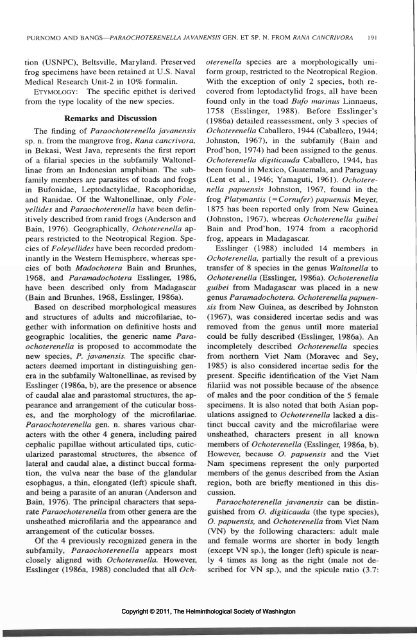The Helminthological Society of Washington - Peru State College
The Helminthological Society of Washington - Peru State College
The Helminthological Society of Washington - Peru State College
You also want an ePaper? Increase the reach of your titles
YUMPU automatically turns print PDFs into web optimized ePapers that Google loves.
PURNOMO AND BANGS—PARAOCHOTERENELLA JAVANENSIS GEN. ET SP. N. FROM RANA CANCRIVORA 191<br />
tion (USNPC), Beltsville, Maryland. Preserved<br />
frog specimens have been retained at U.S. Naval<br />
Medical Research Unit-2 in 10% formalin.<br />
ETYMOLOGY: <strong>The</strong> specific epithet is derived<br />
from the type locality <strong>of</strong> the new species.<br />
Remarks and Discussion<br />
<strong>The</strong> finding <strong>of</strong> Paraochoterenella javanensis<br />
sp. n. from the mangrove frog, Rana cancrivora,<br />
in Bekasi, West Java, represents the first report<br />
<strong>of</strong> a filarial species in the subfamily Waltonellinae<br />
from an Indonesian amphibian. <strong>The</strong> subfamily<br />
members are parasites <strong>of</strong> toads and frogs<br />
in Bufonidae, Leptodactylidae, Racophoridae,<br />
and Ranidae. Of the Waltonellinae, only Foleyellides<br />
and Paraochoterenella have been definitively<br />
described from ranid frogs (Anderson and<br />
Bain, 1976). Geographically, Ochoterenella appears<br />
restricted to the Neotropical Region. Species<br />
<strong>of</strong> Foleyellides have been recorded predominantly<br />
in the Western Hemisphere, whereas species<br />
<strong>of</strong> both Madochotera Bain and Brunhes,<br />
1968, and Paramadochotera Esslinger, 1986,<br />
have been described only from Madagascar<br />
(Bain and Brunhes, 1968, Esslinger, 1986a).<br />
Based on described morphological measures<br />
and structures <strong>of</strong> adults and micr<strong>of</strong>ilariae, together<br />
with information on definitive hosts and<br />
geographic localities, the generic name Paraochoterenella<br />
is proposed to accommodate the<br />
new species, P. javanensis. <strong>The</strong> specific characters<br />
deemed important in distinguishing genera<br />
in the subfamily Waltonellinae, as revised by<br />
Esslinger (1986a, b), are the presence or absence<br />
<strong>of</strong> caudal alae and parastomal structures, the appearance<br />
and arrangement <strong>of</strong> the cuticular bosses,<br />
and the morphology <strong>of</strong> the micr<strong>of</strong>ilariae.<br />
Paraochoterenella gen. n. shares various characters<br />
with the other 4 genera, including paired<br />
cephalic papillae without articulated tips, cuticularized<br />
parastomal structures, the absence <strong>of</strong><br />
lateral and caudal alae, a distinct buccal formation,<br />
the vulva near the base <strong>of</strong> the glandular<br />
esophagus, a thin, elongated (left) spicule shaft,<br />
and being a parasite <strong>of</strong> an anuran (Anderson and<br />
Bain, 1976). <strong>The</strong> principal characters that separate<br />
Paraochoterenella from other genera are the<br />
unsheathed micr<strong>of</strong>ilaria and the appearance and<br />
arrangement <strong>of</strong> the cuticular bosses.<br />
Of the 4 previously recognized genera in the<br />
subfamily, Paraochoterenella appears most<br />
closely aligned with Ochoterenella. However,<br />
Esslinger (1986a, 1988) concluded that all Ochoterenella<br />
species are a morphologically uniform<br />
group, restricted to the Neotropical Region.<br />
With the exception <strong>of</strong> only 2 species, both recovered<br />
from leptodactylid frogs, all have been<br />
found only in the toad Bufo marinus Linnaeus,<br />
1758 (Esslinger, 1988). Before Esslinger's<br />
(1986a) detailed reassessment, only 3 species <strong>of</strong><br />
Ochoterenella Caballero, 1944 (Caballero, 1944;<br />
Johnston, 1967), in the subfamily (Bain and<br />
Prod'hon, 1974) had been assigned to the genus.<br />
Ochoterenella digiticauda Caballero, 1944, has<br />
been found in Mexico, Guatemala, and Paraguay<br />
(Lent et al., 1946; Yamaguti, 1961). Ochoterenella<br />
papuensis Johnston, 1967, found in the<br />
frog Platymantis ( — Cornufer} papuensis Meyer,<br />
1875 has been reported only from New Guinea<br />
(Johnston, 1967), whereas Ochoterenella guibei<br />
Bain and Prod'hon, 1974 from a racophorid<br />
frog, appears in Madagascar.<br />
Esslinger (1988) included 14 members in<br />
Ochoterenella, partially the result <strong>of</strong> a previous<br />
transfer <strong>of</strong> 8 species in the genus Waltonella to<br />
Ochoterenella (Esslinger, 1986a). Ochoterenella<br />
guibei from Madagascar was placed in a new<br />
genus Paramadochotera. Ochoterenella papuensis<br />
from New Guinea, as described by Johnston<br />
(1967), was considered incertae sedis and was<br />
removed from the genus until more material<br />
could be fully described (Esslinger, 1986a). An<br />
incompletely described Ochoterenella species<br />
from northern Viet Nam (Moravec and Sey,<br />
1985) is also considered incertae sedis for the<br />
present. Specific identification <strong>of</strong> the Viet Nam<br />
filariid was not possible because <strong>of</strong> the absence<br />
<strong>of</strong> males and the poor condition <strong>of</strong> the 5 female<br />
specimens. It is also noted that both Asian populations<br />
assigned to Ochoterenella lacked a distinct<br />
buccal cavity and the micr<strong>of</strong>ilariae were<br />
unsheathed, characters present in all known<br />
members <strong>of</strong> Ochoterenella (Esslinger, 1986a, b).<br />
However, because O. papuensis and the Viet<br />
Nam specimens represent the only purported<br />
members <strong>of</strong> the genus described from the Asian<br />
region, both are briefly mentioned in this discussion.<br />
Paraochoterenella javanensis can be distinguished<br />
from O. digiticauda (the type species),<br />
O. papuensis, and Ochoterenella from Viet Nam<br />
(VN) by the following characters: adult male<br />
and female worms are shorter in body length<br />
(except VN sp.), the longer (left) spicule is nearly<br />
4 times as long as the right (male not described<br />
for VN sp.), and the spicule ratio (3.7:<br />
Copyright © 2011, <strong>The</strong> <strong>Helminthological</strong> <strong>Society</strong> <strong>of</strong> <strong>Washington</strong>
















